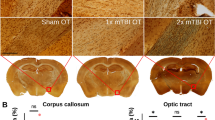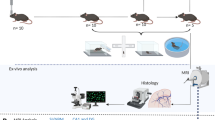Abstract
Traumatic brain injury (TBI) is a major cause of death and disability in young adults. Long-term mental disability often occurs in patients suffering moderate and severe TBI while not as frequent in the victims of mild TBI. To explore the potential mechanism underlying this severity-dependent cognitive deficit, we subjected C57/BL6 mice to different severities of controlled cortical impact (CCI) and assessed their learning-memory functions. The mice subjected to moderate and severe TBI exhibited significantly impaired long-term spatial learning-memory ability, which was accompanied by marked white matter injury and hippocampus damage. In contrast, long-term learning-memory deficits or structural abnormalities within the hippocampus or white matter were not significant in the case of mild TBI. According to a correlation analysis, the hippocampus or white matter injury severity was more relevant to Morris water maze outcome than tissue volume. This study revealed that long-term spatial learning-memory deficits are dependent on the severity of destruction in the white matter and hippocampus. Therapeutic strategies targeting both the white matter and hippocampus may be needed to improve the neurological functions in TBI victims.




Similar content being viewed by others
References
Pringsheim T, Fiest K, Jette N. The international incidence and prevalence of neurologic conditions: how common are they? Neurology. 2014;83(18):1661–4.
CDC, U.S. http://www.cdc.gov/traumaticbraininjury/data/dist_death.html. 2015; Available from: http://www.cdc.gov/traumaticbraininjury/data/dist_death.html.
Greenwald BD, Burnett DM, Miller MA. Congenital and acquired brain injury. 1. Brain injury: epidemiology and pathophysiology. Arch Phys Med Rehabil. 2003;84(3 Suppl 1):S3–7.
Frey LC. Epidemiology of posttraumatic epilepsy: a critical review. Epilepsia. 2003;44 Suppl 10:11–7.
Koskinen S. Quality of life 10 years after a very severe traumatic brain injury (TBI): the perspective of the injured and the closest relative. Brain Inj. 1998;12(8):631–48.
Khan MB et al. Remote ischemic postconditioning: harnessing endogenous protection in a murine model of vascular cognitive impairment. Transl Stroke Res. 2015;6(1):69–77.
Aiguo W, Zhe Y, Gomez-Pinilla F. Vitamin E protects against oxidative damage and learning disability after mild traumatic brain injury in rats. Neurorehabil Neural Repair. 2010;24(3):290–8.
Hou Z et al. Hydrogen-rich saline protects against oxidative damage and cognitive deficits after mild traumatic brain injury. Brain Res Bull. 2012;88(6):560–5.
Spitz G et al. White matter integrity following traumatic brain injury: the association with severity of injury and cognitive functioning. Brain Topogr. 2013;26(4):648–60.
Hill BD et al. Cognitive intra-individual variability has a positive association with traumatic brain injury severity and suboptimal effort. Arch Clin Neuropsychol. 2013;28(7):640–8.
Bellerose J et al. When injury clouds understanding of others: theory of mind after mild TBI in preschool children. J Int Neuropsychol Soc. 2015;21(7):483–93.
Clark AL, et al. Deep white matter hyperintensities affect verbal memory independent of PTSD symptoms in veterans with mild traumatic brain injury. Brain Inj. 2016;30(7):864–71.
Combs HL et al. The effects of mild traumatic brain injury, post-traumatic stress disorder, and combined mild traumatic brain injury/post-traumatic stress disorder on returning veterans. J Neurotrauma. 2015;32(13):956–66.
Gardner RC et al. Dementia risk after traumatic brain injury vs nonbrain trauma: the role of age and severity. JAMA Neurol. 2014;71(12):1490–7.
Wang L et al. Recombinant human erythropoietin improves the neurofunctional recovery of rats following traumatic brain injury via an increase in circulating endothelial progenitor cells. Transl Stroke Res. 2015;6(1):50–9.
Zuloaga KL et al. Neurobehavioral and imaging correlates of hippocampal atrophy in a mouse model of vascular cognitive impairment. Transl Stroke Res. 2015;6(5):390–8.
Schutz C et al. Acute, transient hemorrhagic hypotension does not aggravate structural damage or neurologic motor deficits but delays the long-term cognitive recovery following mild to moderate traumatic brain injury. Crit Care Med. 2006;34(2):492–501.
Pu H et al. Omega-3 polyunsaturated fatty acid supplementation improves neurologic recovery and attenuates white matter injury after experimental traumatic brain injury. J Cereb Blood Flow Metab. 2013;33(9):1474–84.
Wang G et al. Scriptaid, a novel histone deacetylase inhibitor, protects against traumatic brain injury via modulation of PTEN and AKT pathway: scriptaid protects against TBI via AKT. Neurotherapeutics. 2013;10(1):124–42.
Chen Q et al. Chronic hydrocephalus and perihematomal tissue injury developed in a rat model of intracerebral hemorrhage with ventricular extension. Transl Stroke Res. 2015;6(2):125–32.
Turner MJ et al. Reduction of inflammation and preservation of neurological function by anti-CD52 therapy in murine experimental autoimmune encephalomyelitis. J Neuroimmunol. 2015;285:4–12.
Godbolt AK et al. Systematic review of the risk of dementia and chronic cognitive impairment after mild traumatic brain injury: results of the International Collaboration on Mild Traumatic Brain Injury Prognosis. Arch Phys Med Rehabil. 2014;95(3 Suppl):S245–56.
Harris AL et al. Post-stroke apathy and hypersomnia lead to worse outcomes from acute rehabilitation. Transl Stroke Res. 2014;5(2):292–300.
Hill D et al. A systematic research review assessing the effectiveness of pursuit interventions in spatial neglect following stroke. Transl Stroke Res. 2015;6(6):410–20.
Wong GK et al. Early MoCA-assessed cognitive impairment after aneurysmal subarachnoid hemorrhage and relationship to 1-year functional outcome. Transl Stroke Res. 2014;5(2):286–91.
Gao X, Chen J. Mild traumatic brain injury results in extensive neuronal degeneration in the cerebral cortex. J Neuropathol Exp Neurol. 2011;70(3):183–91.
Liu P et al. Inhaled nitric oxide improves short term memory and reduces the inflammatory reaction in a mouse model of mild traumatic brain injury. Brain Res. 2013;1522:67–75.
Tong J et al. Inhibition of Nogo-66 receptor 1 enhances recovery of cognitive function after traumatic brain injury in mice. J Neurotrauma. 2013;30(4):247–58.
Sebastian V et al. Robust training attenuates TBI-induced deficits in reference and working memory on the radial 8-arm maze. Front Behav Neurosci. 2013;7:38.
Zhao H et al. ABCD(2) score may discriminate minor stroke from TIA on patient admission. Transl Stroke Res. 2014;5(1):128–35.
Hsieh CL et al. CCR2 deficiency impairs macrophage infiltration and improves cognitive function after traumatic brain injury. J Neurotrauma. 2014;31(20):1677–88.
Yu YW, et al. Glucose-dependent insulinotropic polypeptide ameliorates mild traumatic brain injury-induced cognitive and sensorimotor deficits and neuroinflammation in rats. J Neurotrauma. 2016. doi:10.1089/neu.2015.4229.
Sehba FA. Rat endovascular perforation model. Transl Stroke Res. 2014;5(6):660–8.
Hamm RJ et al. Cognitive deficits following traumatic brain injury produced by controlled cortical impact. J Neurotrauma. 1992;9(1):11–20.
Hicks RR et al. Mild experimental brain injury in the rat induces cognitive deficits associated with regional neuronal loss in the hippocampus. J Neurotrauma. 1993;10(4):405–14.
Laurer HL et al. Mild head injury increasing the brain’s vulnerability to a second concussive impact. J Neurosurg. 2001;95(5):859–70.
Bolton AN, Saatman KE. Regional neurodegeneration and gliosis are amplified by mild traumatic brain injury repeated at 24-hour intervals. J Neuropathol Exp Neurol. 2014;73(10):933–47.
Meehan 3rd WP et al. Increasing recovery time between injuries improves cognitive outcome after repetitive mild concussive brain injuries in mice. Neurosurgery. 2012;71(4):885–91.
Weil ZM, Gaier KR, Karelina K. Injury timing alters metabolic, inflammatory and functional outcomes following repeated mild traumatic brain injury. Neurobiol Dis. 2014;70:108–16.
Mahut H, Zola-Morgan S, Moss M. Hippocampal resections impair associative learning and recognition memory in the monkey. J Neurosci. 1982;2(9):1214–20.
Pignataro G et al. Does Na(+)/Ca(2)(+) exchanger, NCX, represent a new druggable target in stroke intervention? Transl Stroke Res. 2014;5(1):145–55.
Taylor AN et al. Injury severity differentially alters sensitivity to dexamethasone after traumatic brain injury. J Neurotrauma. 2010;27(6):1081–9.
Almeida-Suhett CP et al. Temporal course of changes in gene expression suggests a cytokine-related mechanism for long-term hippocampal alteration after controlled cortical impact. J Neurotrauma. 2014;31(7):683–90.
Tajiri N et al. Intravenous transplants of human adipose-derived stem cell protect the brain from traumatic brain injury-induced neurodegeneration and motor and cognitive impairments: cell graft biodistribution and soluble factors in young and aged rats. J Neurosci. 2014;34(1):313–26.
Zhang YP et al. Traumatic brain injury using mouse models. Transl Stroke Res. 2014;5(4):454–71.
d’Esterre CD et al. Acute multi-modal neuroimaging in a porcine model of endothelin-1-induced cerebral ischemia: defining the acute infarct core. Transl Stroke Res. 2015;6(3):234–41.
Song M, Yu SP. Ionic regulation of cell volume changes and cell death after ischemic stroke. Transl Stroke Res. 2014;5(1):17–27.
Jane JA, Steward O, Gennarelli T. Axonal degeneration induced by experimental noninvasive minor head injury. J Neurosurg. 1985;62(1):96–100.
Farkas O, Povlishock JT. Cellular and subcellular change evoked by diffuse traumatic brain injury: a complex web of change extending far beyond focal damage. Prog Brain Res. 2007;161:43–59.
Andriessen TM, Jacobs B, Vos PE. Clinical characteristics and pathophysiological mechanisms of focal and diffuse traumatic brain injury. J Cell Mol Med. 2010;14(10):2381–92.
Kraus MF et al. White matter integrity and cognition in chronic traumatic brain injury: a diffusion tensor imaging study. Brain. 2007;130(Pt 10):2508–19.
Zhao J et al. Deferoxamine attenuates acute hydrocephalus after traumatic brain injury in rats. Transl Stroke Res. 2014;5(5):586–94.
Qiu M et al. White matter integrity is a stronger predictor of motor function than BOLD response in patients with stroke. Neurorehabil Neural Repair. 2011;25(3):275–84.
Kemmotsu N et al. MRI analysis in temporal lobe epilepsy: cortical thinning and white matter disruptions are related to side of seizure onset. Epilepsia. 2011;52(12):2257–66.
Genova HM et al. Facial affect recognition linked to damage in specific white matter tracts in traumatic brain injury. Soc Neurosci. 2015;10(1):27–34.
Costanzo ME et al. Connecting combat-related mild traumatic brain injury with posttraumatic stress disorder symptoms through brain imaging. Neurosci Lett. 2014;577:11–5.
Yuan L et al. Use of multisequence 3.0-T MRI to detect severe traumatic brain injury and predict the outcome. Br J Radiol. 2015;88(1052):20150129.
Drijkoningen D et al. Training-induced improvements in postural control are accompanied by alterations in cerebellar white matter in brain injured patients. Neuroimage Clin. 2015;7:240–51.
Strauss SB, et al. Bidirectional changes in anisotropy are associated with outcomes in mild traumatic brain injury. AJNR Am J Neuroradiol. 2016. doi:10.3174/ajnr.A4851.
Wang G et al. HDAC inhibition prevents white matter injury by modulating microglia/macrophage polarization through the GSK3beta/PTEN/Akt axis. Proc Natl Acad Sci U S A. 2015;112(9):2853–8.
Acknowledgments
This project was supported by the Chinese Natural Science Foundation grants 81171149, 81371306, 81571285 (to Dr. Gao), and 81471332 (to Dr. Zhang); the Shanghai Committee of Science and Technology Support Program 14431907002 (to Dr. Gao); and the American Heart Association Scientist Development grant 13SDG14570025 (to Dr. Hu).
Author information
Authors and Affiliations
Corresponding author
Ethics declarations
All national and institutional guidelines for the care and use of animals were followed. All procedures performed in studies involving animals were in accordance with the ethical standards of the institution at which the studies were conducted.
Conflict of Interest
The authors declare that they have no conflict of interest.
Rights and permissions
About this article
Cite this article
An, C., Jiang, X., Pu, H. et al. Severity-Dependent Long-Term Spatial Learning-Memory Impairment in a Mouse Model of Traumatic Brain Injury. Transl. Stroke Res. 7, 512–520 (2016). https://doi.org/10.1007/s12975-016-0483-5
Received:
Revised:
Accepted:
Published:
Issue Date:
DOI: https://doi.org/10.1007/s12975-016-0483-5




